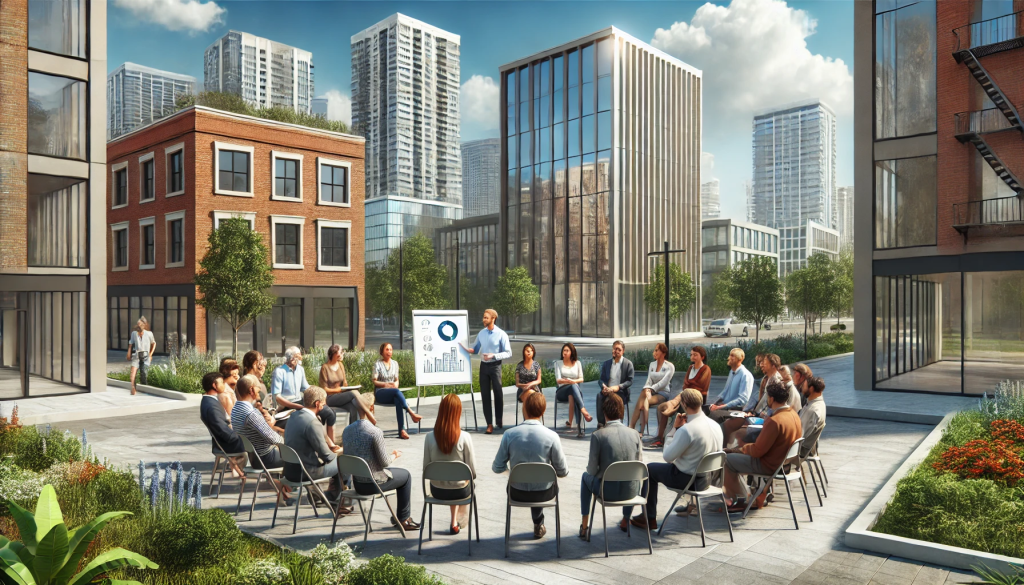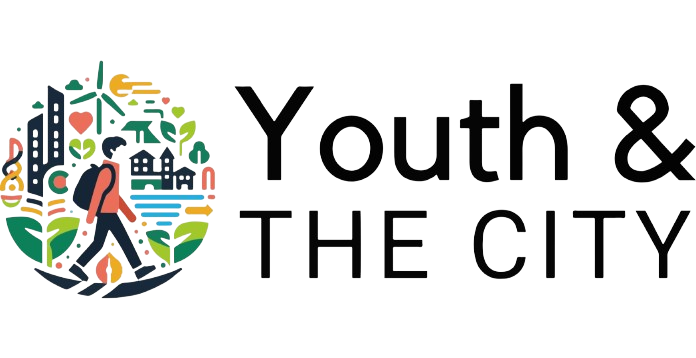Inclusivity and Civic Engagement in Smart Cities
Emphasize inclusivity and citizen participation.
Learning Objectives
- Understand the core principles of Smart Cities 3.0, emphasizing inclusivity and citizen participation.
- Analyze how technology can be leveraged to make cities more accessible, inclusive, and people-centered.
- Explore the role of co-creation and participatory governance in smart urban planning.
- Learn how to recognize and address barriers to participation such as the digital divide and social inequalities.
- Identify practical tools, platforms, and methods to involve citizens in shaping their urban environments.

5 min read
Course Overview
1. Citizen-driven innovations: Co-creating Smart services with the community
2. Social inclusion and equity in smart city planning
3. Technology for the differently-abled: Accessible urban design
4. Participatory governance: Citizens involved in Decision-Making
5. Key Terms - Glossary
6. Activity
7. Quizes
8. Links to external additional resources
9. Bibliography
INTRODUCTION
The Importance of Inclusivity and Civic Engagement in Smart Cities 3.0 represent a new generation of urban development—one that integrates digital innovation with the social dimension of city life. It is not enough for a city to be technologically advanced; it must also be inclusive, equitable, and participatory. At the heart of Smart Cities 3.0 is the recognition that urban development must reflect the needs, aspirations, and ideas of its people.
A smart city is defined not only by its infrastructure and data networks but also by how it fosters collaboration among institutions, communities, and citizens. According to the OECD Principles on Urban Policy, successful cities implement inclusive strategies through shared governance, and 8 out of 11 principles focus directly on building smart, sustainable, and people-centered urban environments.
This module explores the value of civic engagement and how inclusive practices, technology, and innovative governance can shape future cities. You’ll discover how co-creation enhances services, what participatory methods exist, and why equity is key to a functioning smart city.
1. CITIZEN-DRIVEN INNOVATIONS: CO-CREATING SMART SERVICES WITH THE COMMUNITY
Civic engagement is essential to the development of innovative, resilient, and sustainable urban services. Citizen-driven innovation emphasizes not just using technology but also designing it with direct community input. Smart Cities 3.0 enable people to shape urban development through co-creation—working together to define needs, propose ideas, and implement solutions.
Roles of Citizens in Co-Creation
- Explorers: identify and define both existing and emerging urban challenges.
- Ideators: propose creative, citizen-centric solutions.
- Designers: help develop and shape new services and tools.
- Diffusers: share, implement, and scale successful ideas across communities.
The Structure of Co-Creation
- Innovation Ecosystem: a collaborative environment where stakeholders (e.g., citizens, businesses, NGOs) interact around shared challenges.
- Innovation Platform: a digital or physical space designed for structured problem-solving and idea exchange.
Methods for Citizen Engagement
Technology and Edge Computing Edge computing allows data to be processed closer to its source, increasing efficiency and responsiveness. In smart cities, this means that citizen-generated data (e.g., traffic reports or environmental monitoring) can be analyzed locally, enabling:
- Faster decision-making
- Lower data traffic
- Enhanced privacy and security
- Improved service delivery
Rethinking Participation Models
- Top-down: government-led engagement with centralized control
- Bottom-up: grassroots citizen initiatives interacting with institutions
Smart Cities 3.0 integrates both approaches, encouraging local knowledge and co-leadership in development processes.
2. SOCIAL INCLUSION & EQUITY IN SMART CITY PLANNING
Inclusion ensures that all residents—regardless of background—can contribute to and benefit from urban life. Equity, on the other hand, means creating customized pathways so that everyone has the resources needed to participate equally.
From Equality to Equity
- Equality: offering the same resources to everyone
- Equity: allocating resources based on individual needs to ensure fair outcomes
Example: Offering digital training for older adults who may be less familiar with technology compared to younger generations.
Barriers to Participation
- Technological: lack of devices, internet access, or digital skills
- Cultural and Language: minority communities facing exclusion due to linguistic or cultural differences
- Time and Workload: limited availability among working adults
- Disability: limited access to public spaces or services
- Gender Inequity: lower ICT skills and less representation of women in digital initiatives
Understanding the Digital Divide The digital divide refers to the unequal access to digital tools, platforms, and skills across different social groups. Contributing factors include:
- Income and affordability
- Education level
- Geographic location
- Gender norms and stereotypes
- Trust and willingness to engage in digital spaces
Solutions to Close the Gap
- Providing low-cost or free internet and devices
- Digital literacy programs
- Designing inclusive, multilingual, and accessible platforms
- Building trust in technology through community involvement
Why Inclusion Matters Inclusive engagement leads to:
- Better public service outcomes
- Safer and more welcoming cities
- More resilient communities
- New economic and social opportunities
- Representation of marginalized voices in planning and innovation.
3. TECHNOLOGY FOR THE DIFFERENTLY-ABLED: ACCESIBLE URBAN DESIGN
Smart city design must actively consider people with different physical, sensory, and cognitive abilities. Creating barrier-free environments supports independence and ensures that everyone can engage fully in community life.
What Is Assistive Technology? Assistive technologies are specialized tools that enhance the abilities of people with disabilities. They range from digital devices to physical modifications in infrastructure and are designed to:
- Support mobility
- Improve communication
- Facilitate access to services
- Promote independence
Examples of Assistive Technologies
- Visual Impairments: voice-controlled apps, screen readers, walking sticks with sensors
- Mobility Impairments: electric wheelchairs, ramps, GPS-guided navigation aids
- Hearing Impairments: hearing loops, real-time captioning software
- Speech Impairments: communication tabs, voice-assist apps, predictive text keyboards
Universal Design Principles Universal design ensures that environments are inherently accessible to all people. For example:
- Ramps benefit wheelchair users and parents with strollers
- Audio signals help both the blind and distracted pedestrians
Smart Cities must adopt inclusive design principles to remove obstacles and create spaces where everyone can move, interact, and thrive.
4. PARTICIPATORY GOVERNANCE: CITIZENS INVOLVEMENT IN DECISION-MAKING
Beyond participation in planning and feedback, Smart Cities 3.0 empower citizens to be co-decision makers through participatory governance. This involves creating platforms and practices where community members have a direct role in shaping city policies.
Case Studies
These examples show how smart governance can harness local knowledge, support democratic processes, and build more responsive, people-centered cities.
Click here to download the full content!
KEY TERMS - GLOSSARY
- Digital Equity: fair access to digital tools, resources, and training based on individual needs.
- Digital Literacy: the ability to use digital technologies for communication, problem-solving, and creation.
- Digital Divide: the inequality in access to and use of digital technologies across different social groups.
- Co-Creation: the collaborative development of solutions by multiple stakeholders, including citizens.
- Assistive Technology: devices or systems that aid people with disabilities in daily activities.
ACTIVITY : THE SMART CITY CHALLENGE -- A ROLE-PLAYING SIMULATION
Objective: Simulate a smart city environment through role-play to develop empathy, teamwork, and solution-oriented thinking.
Roles:
- City Officials – manage budgets and policy decisions
- Citizens – represent diverse community interests
- Tech Innovators – propose and implement tech-based solutions
- Community Organizations – ensure representation of vulnerable groups
Scenarios to Solve:
- Digital divide in low-income districts
- Poor public transportation infrastructure
- Inaccessible city buildings
- Urban pollution and climate resilience
Steps:
- Assign roles
- Read scenario and group briefing
- Brainstorm potential solutions in teams
- Collaborate across teams to co-create shared proposals
- Present proposed solutions with inclusivity, feasibility, and sustainability in mind
Bonus: Use tools like Mentimeter or AI-based feedback bots to simulate real-time citizen input.
QUIZZES
Quiz 1
Quiz 2
Quiz 3
LINKS TO EXTERNAL ADDITIONAL RESOURCES
Manifesto on Citizen Engagement and Inclusive Smart Cities
Sustainable Development Goals
UN-Habitat’s People-Centered Smart Cities flagship programme
https://unhabitat.org/programme/people-centred-smart-cities
Participatory budgeting website
https://www.participatorybudgeting.org/
Online polling platform
https://www.mentimeter.com/features/live-polling
AI-driven platform for sustainable urban planning and development
Advanced software for 3D urban planning
https://www.esri.com/it-it/arcgis/products/arcgis-cityengine/overview
“Smart Cities in Europe with Alberto Bortolotti”
Unites Citizens of Europe Podcast
https://open.spotify.com/episode/2zfQwlOeohUXO1dZ2m0lbf?si=89eb3525c0c84c3d
BIBLIOGRAPHY
Giffinger, R., Fertner, C., Kramar, H., & Meijers, E., Smart Cities Ranking of European Medium-Sized Cities, Vienna, UT: Centre of Regional Science, 2007.
Russo, F., Rindone C., Panuccio, P., The process of smart city definition at an EU level, The Sustainable City IX, Vol. 2, WIT Transactions on Ecology and the Environment, 2014.
Bvuma, S. (2024). Understanding Citizen Engagement in the Era of Smart Cities. IntechOpen. doi: 10.5772/intechopen.1005673
Dandamudi, V. (2015). Technology and its Advancements Helping the Differently Abled People. International Journal of Science and Research(IJSR), 34-37.
TalTech, Climate-KIC, UNDP. (2024). “Smarter & Inclusive Cities” Course Materials, 2024 Urban Learning Center.
OECD Centre for Entrepreneurship, SMEs, Regions and Cities. (2018). OECD Principles on Urban Policy. Organisation for Economic Co-operation and Development.
Nambisan, S., & Nambisan, P. (2013). Engaging Citizens in Co-Creation in Public Services: Lessons learned and best practices. IBM Center for the Business of Government.
Davis, T., Fuller, M., Jackson, S., Pittman, J., & Sweet, J. (2007). A national consideration of digital equity. The National Center for Education Statistics Report.
https://eric.ed.gov/?id=ED497214
Covello, S. (2010). A review of digital literacy assessment instruments. Syracuse University, School of Education: Analysis for Human Performance Technology Decisions.
Bruno, G., Esposito, E., Genovese, A., & Gwebu, K. L. (2011). A Critical Analysis of Current Indexes for Digital Divide Measurement. The Information Society, 27(1), 16–28
https://doi.org/10.1080/01972243.2010.5343646
Wendt, O., & Lloyd, L. L. (2011). Definitions, history, and legal aspects of assistive technology. In BRILL eBooks (pp. 1–22).
Bastos, D., Fernández-Caballero, A., Pereira, A., & Rocha, N. P. (2022). Smart City Applications to Promote Citizen Participation in city Management and Governance: A Systematic review. Informatics, 9(4), 89.
Accessibility tools

